Balinese Cremation Ceremony Posted by sasha on Jun 14, 2016 in Uncategorized
The culture of Bali is unique in that people practice a form of Hinduism that combines traditional Hindu beliefs with Buddhism and local animist religions. Anyone who visits the Island of the Gods will be able to witness this firsthand, from the daily offerings that can be seen just about anywhere to the elaborate ceremonies that seem to go on every day. One of the most important rituals in Balinese culture is without a doubt the cremation ceremony, known as Ngaben. The name comes from the word ngabuin or ngabu, meaning “turn to ash.” This ceremony is incredibly important to Balinese people, as it represents the spirit being released from the deceased’s body, thus allowing them to either reincarnate or find final rest in Moksha. Let’s take a closer look at a Balinese cremation ceremony and its importance in the local culture.
Preparation
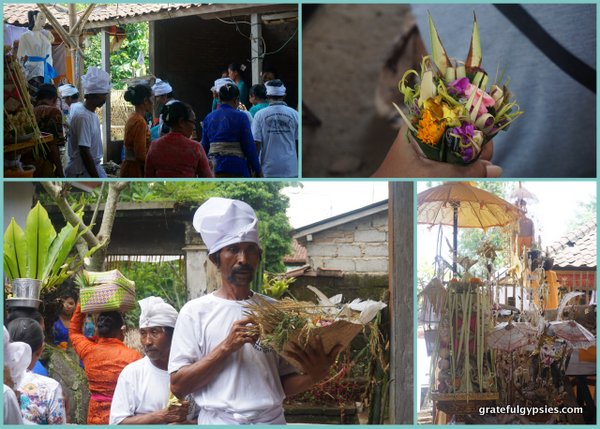
Lots to do to get ready.
When you perform Ngaben very much depends on your place in Bali’s caste system. Those of the more elite castes typically have the ceremony within three days, while those of lower castes may bury the dead temporarily and wait for a mass ceremony at a later date when more people can split the cost. First of all, the proper date must be selected. This is done with the assistance of a priest. Before the ceremony, the body of the deceased will lay as if sleeping. Tears will not be shed, for this is a joyous occasion. Other preparations include making a sarcophagus resembling a buffalo (called a Lembu) and a temple-like structure made of papier-maché and wood (called a Wadah).
Start of the Ceremony

The ceremony begins at home.
Prior to the cremation, it’s common for people to gather in the family’s home. A priest leads prayers, people make offerings, and a band plays traditional music meant specifically for funerals. Rather than a somber, quiet occasion, people are chatting and smiling; the band members even share smokes and little cups of arak in between songs. This goes on for a couple of hours, as friends, family members, and villagers stream in and out to pay their respects.
Procession to the Cemetery
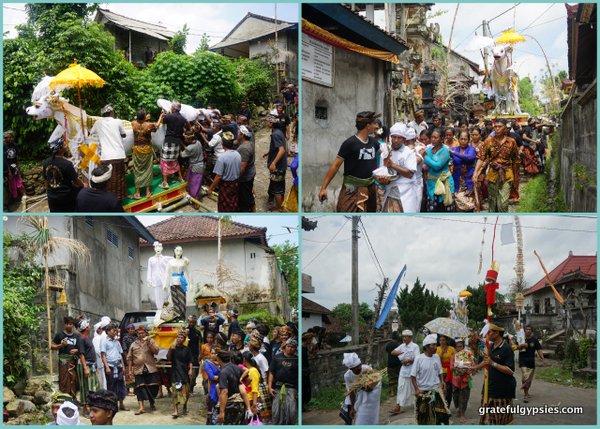
Heading to the cemetery.
Eventually, the body is loaded into the Lembu and a procession to the cemetery begins. The procession is a lively affair, with a large crowd carrying offerings, an orchestra, and more. In addition to the Lembu, it’s common to have a male and female figure as well, representing the deceased and their spouse.
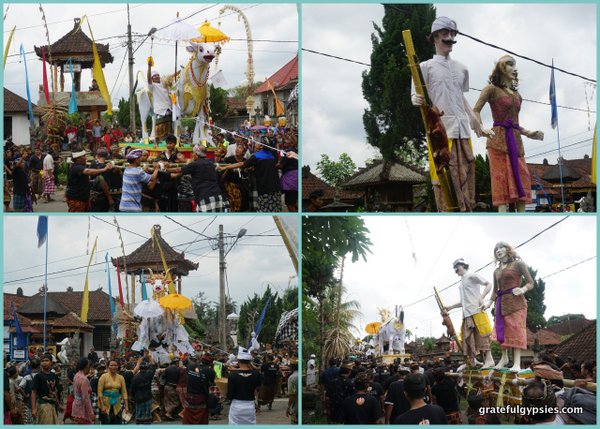
The procession continues.
It’s walked in a zig-zag pattern rather than a straight line so as to confuse evil spirits and keep them away from the deceased. The group must work together to navigate the maze of power lines along the way, and traffic comes to a complete stop for this all-important ceremony.
Cremation
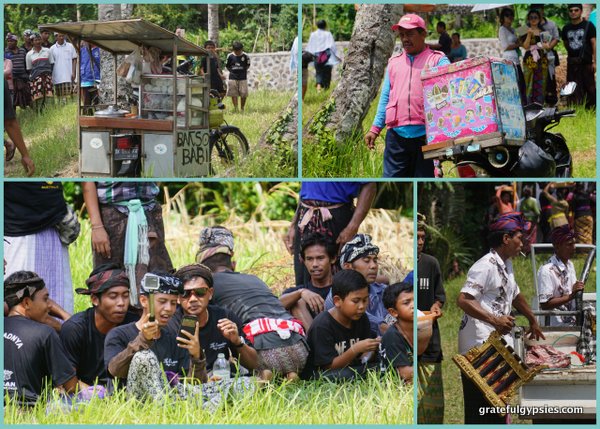
The whole village gathers.
At a large cremation ceremony – such as the one I attended in my teacher’s village where three people were being cremated – it’s common for the entire village to show up. It’s far from the tears and condolences of a Western funeral, as people snap selfies, light cigarettes, and even pick up some mie bakso (meatball soup) or ice cream from vendors.

Some scenes from the cemetery.
Each village has a designated area for such ceremonies. Family members bring elaborate offerings to leave for the deceased. Others simply sit off to the side and take in the ceremony, many snapping photos and videos.
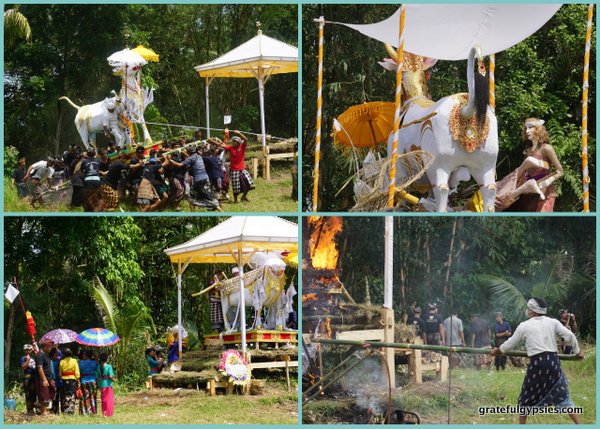
Preparing for the cremation.
Once the Lembu has been placed inside the Wadah, the fire is lit. The statues that were also used in the procession are tossed in as well, helping to fuel the fire. One villager with a long bamboo stick is in charge of keeping the fire going, with it soon engulfing the entire Lembu.

The Lembu burns in the ceremony.
The fire is necessary to free the spirit from the body of the deceased and enable reincarnation. The ashes are collected at the end of the ceremony, and 12 days later are scattered into the sea or a nearby river that leads to it. This is another occasion entirely, and as you may come to expect from Bali at this point, it’s quite elaborate.
Should you find yourself invited to a cremation ceremony in Bali, remember to wear traditional, formal dress. Most people don’t mind if you take photos – in fact you’ll see locals taking tons of them – but it is polite to ask for permission in advance. Keep in mind that a cremation ceremony is reason to celebrate in Balinese culture, so be sure to smile, greet people, and enjoy the festivities along with everyone else.

Build vocabulary, practice pronunciation, and more with Transparent Language Online. Available anytime, anywhere, on any device.
About the Author: sasha
Sasha is an English teacher, writer, photographer, and videographer from the great state of Michigan. Upon graduating from Michigan State University, he moved to China and spent 5+ years living, working, studying, and traveling there. He also studied Indonesian Language & Culture in Bali for a year. He and his wife run the travel blog Grateful Gypsies, and they're currently trying the digital nomad lifestyle across Latin America.



